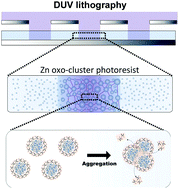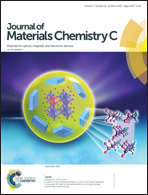Chemical and structural investigation of zinc-oxo cluster photoresists for DUV lithography
Abstract
Metal oxo cluster photoresists have drawn a lot of attention in recent years due to their interesting properties combining the advantages of both inorganic and organic features. Their organic functionalities offer the possibility of patterning them by photon or electron beam lithography into metal oxide micro or nanostructures. Thanks to the inorganic metal oxide frameworks, these patterns show higher etch resistance and refractive index in the visible light range than neat organic patterns. Moreover, the nanosize of the photoresist building blocks makes them suitable for high resolution lithography. To have an in-depth understanding of the effect of physicochemical parameters on the size, shape and physical properties of photo-patterned structures, a detailed investigation was carried out on a zinc-oxo cluster photoresist combined with deep ultraviolet (DUV) lithography. The results show the impact of both DUV irradiation and thermal treatment on material patterning. The impact of crystallization is particularly discussed since it has a strong influence on the shape of patterns.



 Please wait while we load your content...
Please wait while we load your content...